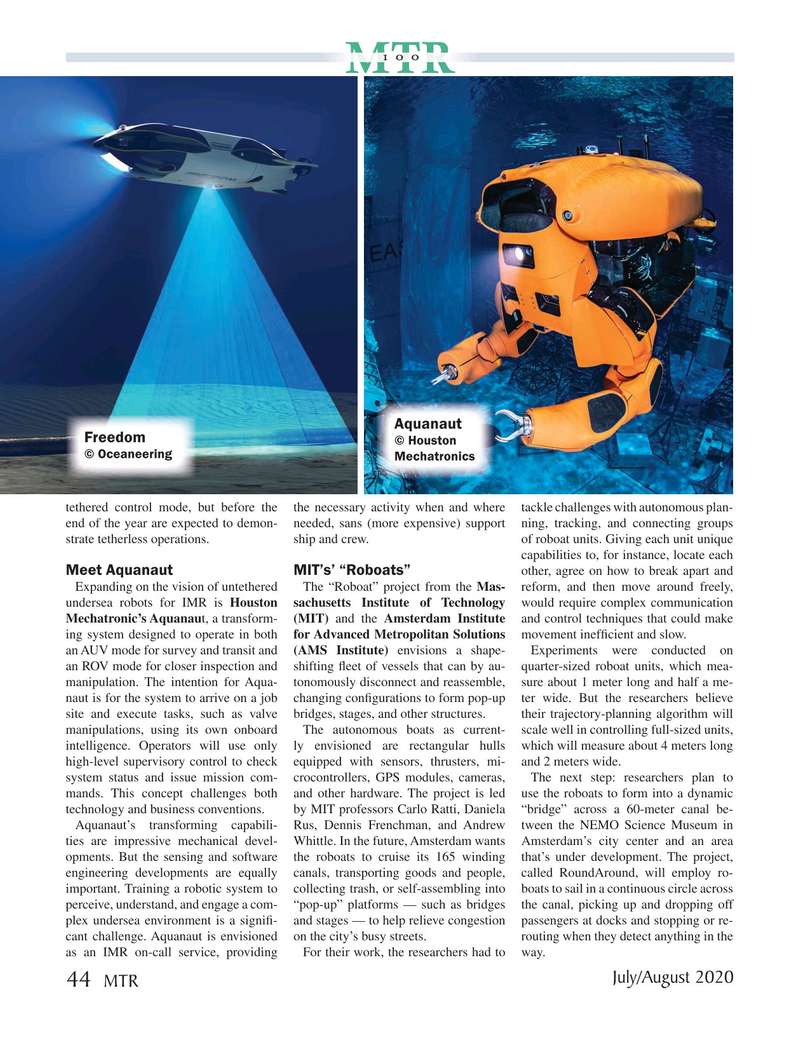
Page 44: of Marine Technology Magazine (July 2020)
Read this page in Pdf, Flash or Html5 edition of July 2020 Marine Technology Magazine
100
MTRMTR
Aquanaut
Freedom © Houston © Oceaneering
Mechatronics tethered control mode, but before the the necessary activity when and where tackle challenges with autonomous plan- end of the year are expected to demon- needed, sans (more expensive) support ning, tracking, and connecting groups strate tetherless operations. ship and crew. of roboat units. Giving each unit unique capabilities to, for instance, locate each
Meet Aquanaut MIT’s’ “Roboats” other, agree on how to break apart and
Expanding on the vision of untethered The “Roboat” project from the Mas- reform, and then move around freely, undersea robots for IMR is Houston sachusetts Institute of Technology would require complex communication
Mechatronic’s Aquanaut, a transform- (MIT) and the Amsterdam Institute and control techniques that could make ing system designed to operate in both for Advanced Metropolitan Solutions movement inef? cient and slow.
an AUV mode for survey and transit and (AMS Institute) envisions a shape- Experiments were conducted on an ROV mode for closer inspection and shifting ? eet of vessels that can by au- quarter-sized roboat units, which mea- manipulation. The intention for Aqua- tonomously disconnect and reassemble, sure about 1 meter long and half a me- naut is for the system to arrive on a job changing con? gurations to form pop-up ter wide. But the researchers believe site and execute tasks, such as valve bridges, stages, and other structures. their trajectory-planning algorithm will manipulations, using its own onboard The autonomous boats as current- scale well in controlling full-sized units, intelligence. Operators will use only ly envisioned are rectangular hulls which will measure about 4 meters long high-level supervisory control to check equipped with sensors, thrusters, mi- and 2 meters wide. system status and issue mission com- crocontrollers, GPS modules, cameras, The next step: researchers plan to mands. This concept challenges both and other hardware. The project is led use the roboats to form into a dynamic technology and business conventions. by MIT professors Carlo Ratti, Daniela “bridge” across a 60-meter canal be-
Aquanaut’s transforming capabili- Rus, Dennis Frenchman, and Andrew tween the NEMO Science Museum in ties are impressive mechanical devel- Whittle. In the future, Amsterdam wants Amsterdam’s city center and an area opments. But the sensing and software the roboats to cruise its 165 winding that’s under development. The project, engineering developments are equally canals, transporting goods and people, called RoundAround, will employ ro- important. Training a robotic system to collecting trash, or self-assembling into boats to sail in a continuous circle across perceive, understand, and engage a com- “pop-up” platforms — such as bridges the canal, picking up and dropping off plex undersea environment is a signi? - and stages — to help relieve congestion passengers at docks and stopping or re- cant challenge. Aquanaut is envisioned on the city’s busy streets. routing when they detect anything in the as an IMR on-call service, providing For their work, the researchers had to way.
July/August 2020 44
MTR
MTR #6 (34-49).indd 44 8/12/2020 5:31:13 PM

 43
43

 45
45
